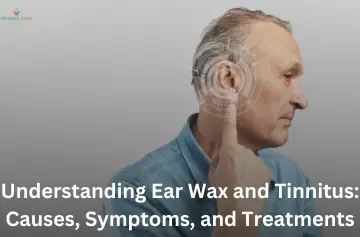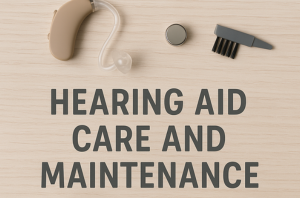Understanding Ear Wax and Tinnitus: Causes, Symptoms, and Treatments
Understanding Ear Wax and Tinnitus: Causes, Symptoms, and Treatments Ear wax, medically called cerumen, and tinnitus are two ear conditions that are very common across the universe, with millions of people suffering from them. Even though these conditions are commonplace, they are in most cases misinterpreted causing avoidable troubles and worry. The ear wax equally is very important as it helps in healthy ear maintenance by collecting dust, dirt and other materials that would otherwise go to the eardrum. It also has lubrication and anti-bacterial activities, which help to keep the ear canal free from disease-causing organisms. However, when excess ear wax is produced and deposited within the ear canal, it is associated with several complications such as deafness, ear pain and tinnitus. Tinnitus is a ringing, buzzing or hissing sound in the ears which is incessant and can be very annoying. It has a debilitating effect on those who experience it and it has no respect for age. The association of ear wax and tinnitus is of greater significance because excess ear wax is an important causative factor of tinnitus. Therefore, it is vital to know how to manage and prevent these disorders by understanding the causes, manifestations and modes of treatment for these disorders. This informative report focuses on the reasons for the significance of ear wax, problems related to ear wax when it is in excess and the correlation of ear wax with tinnitus. We trust that by investigating these issues, we will offer helpful information and effective approaches to those who suffer from such conditions. This article is exhaustive enough to take care of your needs whether you are troubled with ear wax, suffer from tinnitus, or simply seek to have a better understanding of such conditions. What is Ear Wax? Ear canal glands produce cerumen, otherwise called ear wax. It has several functions that are important for the ears: Protection: Ear wax acts like a trap by keeping dust and dirt along with other elements from reaching the eardrum. Lubrication. Ear wax keeps the ear canal moist, preventing dryness and itching. Antibacterial properties: Ear wax contains natural antibacterial properties that prevent infections. Why may ear wax be excessive? Ear wax, though helpful, becomes problematic in the event of excessive buildup, where an individual suffers from losing the ability to hear effectively, ear pain, and ringing in the ear. Some of the common causes of excessive ear wax include the following: Excessive production: Some people tend to produce excess ear wax than others. Ear canal shape: Narrow or abnormally shaped ear canals may hinder the smooth exit of ear wax from the ear. Pushing ear wax further down the canal by inserting cotton swabs or other objects in your ears is one cause of ear wax blockages. Knowing Tinnitus Tinnitus refers to the phenomenon of noise or ringing in the ears without any outside sound. It can range from mild to more severe, as well as be transient or persistent. Most people with tinnitus experience a ringing, buzzing, hissing, or clicking. Diagnosing Ear Wax Buildup and Tinnitus. If excessive ear wax is noticed, it is important to visit a doctor for appropriate medical attention. Such a medical practitioner can: Carry out a physical examination of the ear. Attach an otoscope tool for better examination of the ear’s internal structure. Prescribe medication to clear any ear wax build-up if necessary. Record the history of the presenting complaint and perform other pertinent examinations. Working with other medical specialists to perform interdisciplinary procedures for patients with multiple ear problems. In Tinnitus, for example, ear candles, which were available even in ancient Egypt, were used because those suffering from this condition often feel an itching sensation in the ears. To look at the ear: An otoscope may help the doctor to see the ear canal and assess it for the presence of earwax. Symptom assessment: When you have particular symptoms, and some additional ones that may have contributed, talk about them to the physician. Assessing Tinnitus to assess a patient for tinnitus, a physician might: Hearing test: Another test to assess his hearing or the presence of deafness. Look in the ears: Check for the presence of excess ear wax or any signs of an infection. Take a history: Consider other medical issues or medications that may be related to the tinnitus. Management Strategies for Tinnitus and Ear Wax Buildup Treatment of Excess Ear Wax buildup is excessive and may need undergoing treatment in several ways: Ear drops: Ear drops that can be bought without a prescription may help in softening the ear wax thus making it easy to clear the wax of the ear. Irrigation: A healthcare provider may scale down the ear wax with the use of water or a saline solution. Manual removal: In some instances, a doctor may be required to clear the ear wax from a patient’s ear by inserting some of the specialized tools into the ear. Management of Tinnitus: Tinnitus management will depend on the cause. Some of the frequently used methods include: Ear wax removal: In the instances when tinnitus is the result of intruding ear wax the intrusion of ear wax is normally treated. Hearing aids: To those who are completely deaf sound amplification devices may enhance hearing and help with tinnitus. Masking: Relief may be achieved by introducing masking noises to distract from or cover the tinnitus. Cognitive therapeutic approach (CBT): CBT can help in addressing the struggle of living with constant tinnitus. Treatment: There are cases where medication may be used to ease the discomfort brought about by tinnitus. Preventing Ear Wax Buildup and Tinnitus Nowadays, we can control almost every medical problem, especially in the modern world where technology plays a significant role in the treatment of patients changes. Ear Wax Buildup Excessive ear wax buildup can be prevented by: Do not put anything in the ear: Do not use cotton buds to do the ear canal. Instil drops in the ear: Regular use of ear drops










